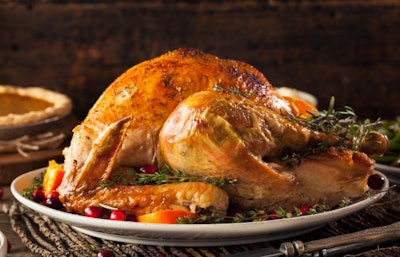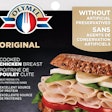
Domestic turkey production fell slightly in 2020 as the country and the world dealt with the COVID-19 pandemic.
According to WATT Global Media’s annual survey of U.S. poultry companies, the top U.S. turkey companies produced 2.247 billion pounds of live turkeys in 2020. That’s 76.1 million fewer pounds, or 1.05% less than the 7.171 billion pounds it produced in 2019. In 2018, the industry produced 7.358 billion pounds.
2020 also marked the third consecutive year-to-year decline in overall turkey production in the United States. From 2017 to 2020, production has dropped by 279.50 million pounds, or about 3.75%.
Production slide continues during pandemic
Like other animal proteins, turkey saw its demand profile rocked by the global COVID-19 pandemic. In the U.S., consumers bought more at retail while dining out and traveling less. That hampered foodservice demand.

Looking ahead to 2021, the industry could see a rebound if foodservice demand returns in 2021. (Tertman I Shutterstock.com)
West Liberty Foods, the 11th largest turkey company in terms of overall slaughter, said in May 2020 it would need to furlough about 300 employees and suspend poult placements due to the drop in demand from foodservice. In December 2020, the company said the furlough would last from January 4, 2021, to February 8, 2021, due to poult placements resuming in the field sooner than expected.
Thomas Elam, president of Indiana-based poultry consultancy FarmEcon LLC, said the industry saw severe declines in total turkey demand in 2020.
According to U.S. Department of Agriculture figures, total turkey use in 2020 declined almost as much as it did during the highly pathogenic avian influenza (HPAI) outbreak of 2015. Turkey production, declining overall due to poor financial performance as an industry, reduced at a faster rate during 2020, he said, due to the disappearance of so much foodservice demand.
The turkey industry in particular suffered from COVID-19 canceling many family gatherings like Thanksgiving and the winter holidays that often feature a large turkey at the center of the table. In 2020, turkey prices rose while the demand fell, indicating demand was weak due to public health restrictions.
Looking ahead to 2021, the industry could see a rebound, however. He said current figures indicate overall stocks are almost as low as they were during the HPAI crisis of 2020. If foodservice demand returns in 2021, it would be a boost for the industry.
Changing consumer behavior wasn’t all bad for the industry, however. John Niemann, president of protein ingredients and international channel for Cargill Protein, said new behaviors related to the pandemic helped turkey gain a larger share of the overall American protein market. In a virtual agricultural summit held in August 2020, he said through the first eight months of the year total purchases of fresh turkey increased in volume by 26% compared with the same period the prior year.
Feed costs will play a major role in 2021. At the end of 2020, costs spiked squeezing industry profit margins, he said. Further reduction of turkey production in 2021 in reaction to decreased demand will support turkey prices, especially if some demand returns in 2021.
Top companies report losses
The majority of U.S. turkey is processed by four companies: Butterball LLC, Jennie-O Turkey Store LLC, Cargill Protein and Farbest Foods Inc. These four companies represent 55% of production and saw their overall slaughter fall by 2% from 2019 to 2020.
Butterball and Jennie-O are both tied to publicly traded companies, which allows insight into the financial performance of the companies who accounted for 34.5% of turkey slaughter in 2020.

Like other animal proteins, turkey saw its demand profile rocked by the global COVID-19 pandemic. (Lightspring | Shutterstock.com)
Seaboard Corp., which owns a 50% non-controlling interest in Butterball, reported losses on its investment in Butterball in 2020. In February 2020, it reported a $21 million loss on its investment in Butterball during 2019. In October 2020, Seaboard reported it had lost $47 million on its investment in the integrated turkey company through the first nine months of its fiscal 2020.
In December 2020, Butterball announced plans to scale back operations at its turkey processing plant in Carthage, Missouri, to balance production with demand. That ramp-down was expected to be complete by March 2021. In January 2021, Butterball announced plans to invest $8.7 million to upgrade facilities in Ozark and Huntsville, Arkansas.
Hormel Foods Corp., the owner of Jennie-O, reported the turkey operation was profitable, earning profits of $38.6 million and $27.4 million, in the first and second quarters of 2020. In its third quarter report, released August 2020, it said higher retail sales of turkey did not offset a decrease in foodservice, commodity and whole bird demand. Profits fell 67% compared with the same quarter of the previous year. Executives cited higher manufacturing, live production and incremental costs related to the impact of the COVID-19 pandemic.
In its survey response, Farbest Foods said it spent $15 million on continued renovations of its Huntingburg, Indiana, processing plant which added automated evisceration and increased chilling capacity. In 2021, it plans on continuing that project with another $22 million worth of improvements including front half deboning and automated wing deboning.
Capital improvements
Despite the pressure of the pandemic, some turkey companies did carry out improvements in 2020 or plan improvements for the future during the year:
- Cooper Farms opened a new recruiting and training center in St. Henry, Ohio, in July 2020.
- In 2021, Dakota Provisions plans on adding a $5.4 million automated deboning system and automated packaging lines worth $500,000.
- Plainville Farms planned on adding a total of $1.5 million worth of improvements in 2020. This included adding refrigeration improvements and adding a new patty line.
- In December 2020, Prestage Farms President Ron Prestage said the company was considering building a turkey plant in South Carolina that is optimized for the post COVID-19 world.
- In 2020, Jaindl added a new starter and grow-out facility, according to its survey response. It plans on adding another new starter and grow-out facility in 2021.
Reviewing COVID-19’s impact on turkey in 2020:
www.WATTPoultry.com/articles/42122















